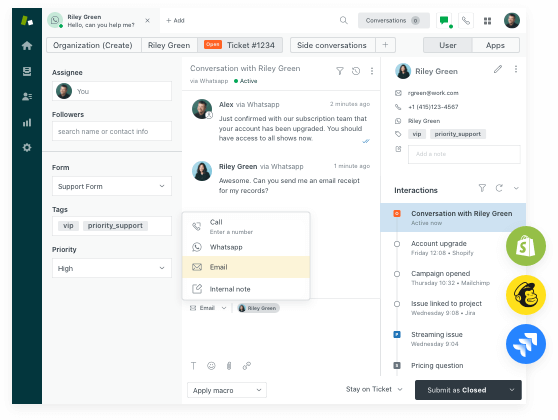Support gets social with social media customer service

What is social media customer service?
Last updated May 3, 2023
Social media customer service is a strategy of providing customer service through social channels like Facebook and Twitter. Due to the potential for high engagement between brands and customers, social media and customer service, when handled properly, work very well together.
Zendesk’s entire experience is streamlined and all conversations and data are captured in a single locations, so agents can provide personalized service experiences to customers.
A different approach to social media customer support
Social customer service is something that’s been around since social media, but it’s still a challenge for many companies both large and small. Customer expectations are rising. Expectations of customer service via social channels are rising to the point that many now expect the same level of service they’re used to fromcall center solutionsandlive chatto those onTwitter, Facebook, and other social channels. Having a robotic social media presence is no longer enough; companies must understand each specific social network and create strategies for each. The benefits—like improved sales and better customer loyalty—are well worth it.

Best practices for social media customer service
社会媒体的成功客户服务,all other customer service, depends on the quality of care provided. However, there is one important difference that must be taken into account: in general, social media customer service will often take place in public or near-public environments. Extra care must be taken because these interactions can be broadcast to a customer’s friends and followers, and possible their friends and followers. Communications from agents should be timely, accurate, sensitive, brief, and friendly. Here are some high-level tips to ensure top quality social media customer service:
- Speed matters. Try to resolve issues quickly—or at least set the expectation that you will try. This can be tough without Triggers or other automated responses, but a pre-written messaging catered to each social channel that lets the customer know you’ve seen their comment and that you’re working on a resolution will buy some time. Only try to resolve simple issues and questions posed over social media if the answer can be public. Otherwise, provide a first response over social media that moves the conversation to something more private. However…
- Speed isn’t the only issue. Agents shouldn’t address a request for a support in a way that the issues isn’t actually dealt with. Agents should use the same skills they use in more traditional channels to understand the customer’s emotional state and decide when the tone of social media is appropriate for conveying friendliness, or when something more official is required.
- Listen to customers. Customer service should take a tip from marketing and use social media monitoring tools to sort through brand mentions on social media social media. This way, they can gather and evaluate customer activity so that they understand which issues are most often raised on social channels and develop specific responses.
- Turn negatives into positives. It’s a fact of life that consumers are more likely to broadcast bad experiences than good ones on social media. Companies can’t control that, but they can control how they respond. Treat negative feedback as a chance to upgrade the brand’s image, and more importantly the relationship with the customer. Even when a comment isn’t sent directly to the company, a response will let the customer know you’re listening and want to improve.
The right time
Companies that find that customers are writing about them in social media are falling through the cracks of their support infrastructure should invest in a solution. Not doing so, or treating social media outside traditional customer service, causes companies to run the risk of losing out on opportunities to engage or respond to public complaints.
How Zendesk helps
Zendesk integrates with social media like Twitter and Facebook. Conversations on those networks can automatically be converted intotickets, allowing agents to respond to andresolve issuesas effectively as any other channel. Zendesk also enables agents to switch between public conversations, such as Tweets, to private conversations with customer or other agents, ensuring sensitive information is never publicly broadcast. The entire experience is streamlined and all conversations and data are captured in a single locations, so agents can provide personalized service experiences to customers.
We have more to say about this. Have a look below.
Social media might be a newer technology, but Zendesk has plenty of resources to help you take full advantage.





